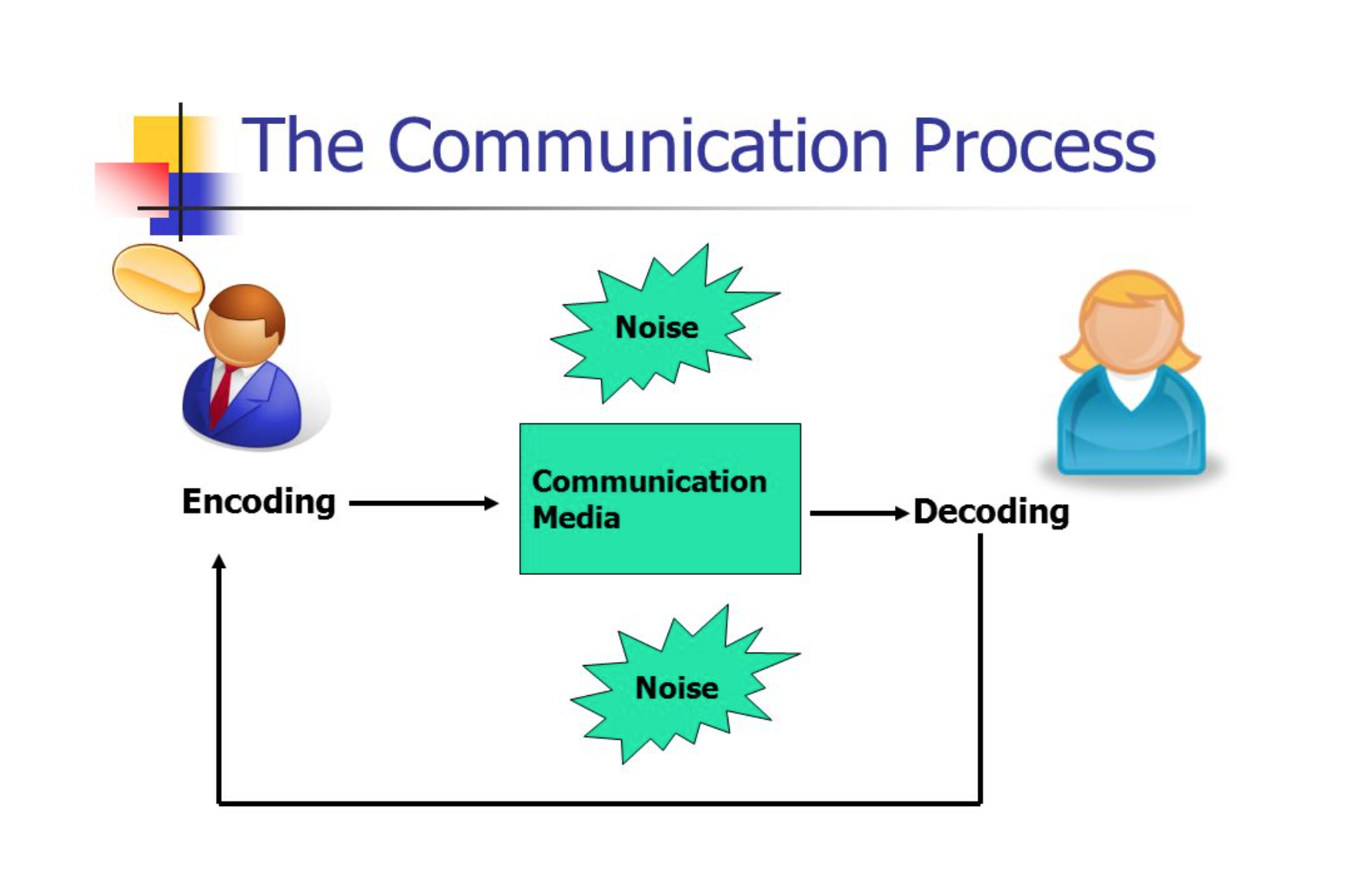The Choice of a Communication Channel Can Convey a Symbolic Meaning to the Receiver.
Chapter 1: Professional Business organization Advice
3 Communications Procedure: Encoding and Decoding
In basic terms, humans communicate through a process of encoding and decoding. The encoder is the person who develops and sends the bulletin. Every bit represented in Figure 1.i below, the encoder must determine how the message will be received by the audition, and make adjustments so the bulletin is received the fashion they want information technology to be received.
Encoding is the process of turning thoughts into communication. The encoder uses a 'medium' to ship the message — a phone phone call, e-mail, text message, face-to-face meeting, or other communication tool. The level of conscious thought that goes into encoding letters may vary. The encoder should also take into business relationship any 'noise' that might interfere with their bulletin, such every bit other messages, distractions, or influences.
The audience then 'decodes', or interprets, the message for themselves. Decoding is the process of turning communication into thoughts. For instance, you may realize yous're hungry and encode the following message to send to your roommate: "I'm hungry. Exercise yous want to go pizza tonight?" As your roommate receives the message, they decode your communication and turn it back into thoughts to make significant.

Figure one.ane. The communication process. Encoding, media, and decoding (Hawkins, 2016).
Of course, you don't just communicate verbally—you have various options, or channels, for communication. Encoded letters are sent through a channel, or a sensory route, on which a bulletin travels to the receiver for decoding. While communication can be sent and received using any sensory route (sight, smell, touch, gustatory modality, or sound), nearly communication occurs through visual (sight) and/or auditory (audio) channels. If your roommate has headphones on and is engrossed in a video game, you may demand to get their attention by waving your hands before y'all can enquire them about dinner.
The transmission model of communication describes communication as a linear, one-way procedure in which a sender intentionally transmits a message to a receiver (Ellis & McClintock, 1990). This model focuses on the sender and message within a communication run into. Although the receiver is included in the model, this role is viewed as more of a target or cease indicate rather than part of an ongoing process. Y'all are left to presume that the receiver either successfully receives and understands the message or does not. Remember of how a radio message is sent from a person in the radio studio to you listening in your car. The sender is the radio announcer who encodes a exact message that is transmitted past a radio tower through electromagnetic waves (the aqueduct) and somewhen reaches your (the receiver'south) ears via an antenna and speakers in lodge to be decoded. The radio journalist doesn't really know if y'all receive their bulletin or not, but if the equipment is working and the channel is gratuitous of static, then there is a good chance that the message was successfully received.
The interaction model of advice describes communication as a process in which participants alternate positions as sender and receiver and generate pregnant by sending messages and receiving feedback within physical and psychological contexts (Schramm, 1997). Rather than illustrating communication as a linear, ane-way procedure, the interaction model incorporates feedback, which makes communication a more interactive, two-way process. Feedback includes messages sent in response to other messages. For example, your instructor may answer to a point you raise during form word or you may point to the sofa when your roommate asks you where the remote control is. The inclusion of a feedback loop also leads to a more complex understanding of the roles of participants in a communication meet. Rather than having one sender, one message, and ane receiver, this model has 2 sender-receivers who exchange letters. Each participant alternates roles every bit sender and receiver in order to keep a advice meet going. Although this seems like a perceptible and deliberate process, y'all alternate between the roles of sender and receiver very apace and frequently without witting thought.
The transaction model of communication describes communication equally a process in which communicators generate social realities within social, relational, and cultural contexts. In this model, you lot don't just communicate to exchange letters; yous communicate to create relationships, form intercultural alliances, shape your self-concepts, and engage with others in dialogue to create communities. In brusk, you don't communicate virtually your realities; advice helps to construct your realities (and the realities of others).
The roles of sender and receiver in the transaction model of advice differ significantly from the other models. Instead of labeling participants equally senders and receivers, the people in a advice come across are referred to every bit communicators. Unlike the interaction model, which suggests that participants alternate positions as sender and receiver, the transaction model suggests that you lot are simultaneously a sender and a receiver. For instance, when coming together a new friend, you send exact messages about your interests and groundwork, your companion reacts nonverbally. You don't look until you are done sending your exact message to start receiving and decoding the nonverbal messages of your new friend. Instead, y'all are simultaneously sending your verbal bulletin and receiving your friend'southward nonverbal messages. This is an important addition to the model because it allows you to understand how you lot are able to adapt your advice—for case, adapting a verbal message—in the centre of sending it based on the communication yous are simultaneously receiving from your communication partner.
Source: https://ecampusontario.pressbooks.pub/commbusprofcdn/chapter/1-2/
0 Response to "The Choice of a Communication Channel Can Convey a Symbolic Meaning to the Receiver."
Publicar un comentario